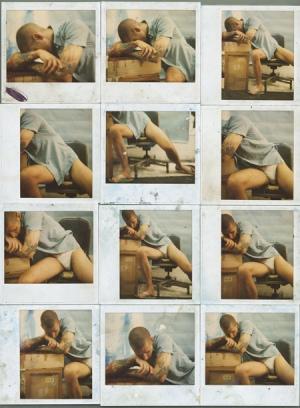With artist Attila Richard Lukacs’ latest exhibit, the Art Gallery of Alberta (AGA) is ready to engage Edmontonians in dialogue about the role of art in society.
The exhibit, Polaroids: Attila Richard Lukacs and Michael Morris, is made up over 3,000 Polaroids that Lukacs took over a 20 year span. Lukacs’ long time mentor, friend and fellow artist Morris collected and assembled the photos for the exhibit.
Equal parts Caravaggio and Mapplethorpe, much of Lukacs’ Polaroids feature naked and nearly naked young men, many of them sex workers Lukacs recruited at the infamous Zoo station in Berlin on his way to his nearby studio.
Morris grouped the Polaroids together in grids, resembling a filmstrip. The viewer can see the ways in which Lukacs directed the men in order to capture the perfect reference from which to paint. In some of the Polaroid series, men can be seen injecting drugs, while in others they are recreating a mugging, sucking on a bottle like a baby, and referencing neo-Nazi youth.
The exhibit is the first time all of the Polaroids have been shown together — something that Lukacs envisioned 25 years ago in his Berlin studio. “I have always wanted to do a survey of my Polaroids,” says Lukacs standing in the exhibit at the AGA. “Within a year of getting started taking Polaroids, I realized I would make a show when I had a critical mass of them.”
Having the Polaroids shown first in Alberta is nothing special for Lukacs. He feels no nostalgia for the province that he was born in. “When you are an artist,” Morris explains for Lukacs, “art is your culture, art is your country.”
The AGA is aware that the exhibit might elicit some controversy in Alberta, a province whose government has still not fully recognized the Supreme Court decision that mandated sexual orientation be covered in human rights legislation across Canada.
As they began to do with their last large scale show, Imaging Science, and intend to do with sizable shows in the future, the AGA brought together an advisory group for the Polaroids show. This group was made up of members of both Edmonton’s artistic and queer communities including contemporary dance producer Brian Webb and Anne Whitelaw, an associate professor in the Department of Art and Design at the University of Alberta.
Stemming from the advisory meeting was the idea to hold a panel discussion asking the question “Can Art Make the World A Better Place?” on May 17, the International Day Against Homophobia, with Lukacs’ work acting as both a figurative and literal backdrop for the discussion. Panelists will include Andre Grace, the director of the University of Alberta’s Institute for Sexual Minority Studies and Services and five-time city councillor Michael Phair.
Leading up to the panel discussion, the AGA will also host interactive tours of the exhibit with members of Edmonton’s queer community including Todd Janes, the programming director of Exposure: Edmonton’s Queer Arts and Culture Festival.
The AGA has also organized a lecture series that will explore the role of museums and art galleries in creating and understanding culture.
“It was a very historic time in Berlin when Lukacs was beginning to use Polaroids in his work, the Berlin wall had just fallen and unification was beginning,” says Anthea Black, the AGA’s exhibitions manager.
As Black sees it, “Lukacs is so fearless in his work, as a gallery we should not shy away from engaging the public in potentially controversial topics that his work may bring up, we want to offer our space for those dialogues to happen.”
The Polaroids show is the AGA’s first ever internationally touring show, a fact Black thinks is something for the gallery to be proud of. “It is a collection of work from an artist that spent formative years in Alberta and has become an internationally know artist.”
Metro Cinema will also be showing Attila Richard Lukacs: Drawing out the Demons, a documentary that covers Lukacs time battling addiction in New York. And as part of the Jarman Does Edmonton weekend, Derek Jarman’s Caravaggio will also be screening.

 Why you can trust Xtra
Why you can trust Xtra


